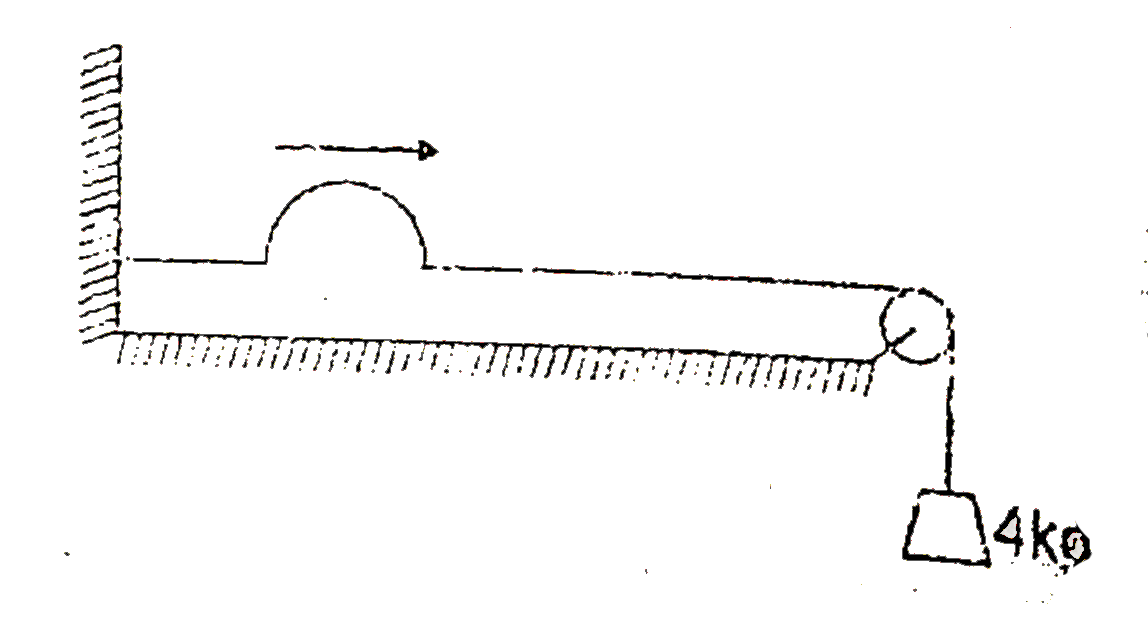Calculate the velocity of the travelling pulse as shown in the figure below. The linear mass density of pulse is 0.25 kg m−1. Further, compute the time taken by the travelling pulse to cover a distance of 30 cm on the string.

The tension in the string is T=mg=1.2×9.8=11.76N
The mass per unit length is μ=0.25kgm−1
Therefore, velocity of the wave pulse is
v=√Tμ=√11.760.25=6.858ms−1=6.8ms−1
The time taken by the pulse to cover the distance of 30 cm is
t=dv=30×10−26.8 = 0.044 s = 44 ms where, ms= milli second.
Topper's Solved these Questions
- BOOK - NCERT TAMILCHAPTER - WAVESEXERCISE - EVALUATION(I. MULTIPLE CHOICE QUESTIONS)15videos
WAVES
- BOOK - NCERT TAMILCHAPTER - WAVESEXERCISE - EVALUATION(IV. NUMERICAL PROBLEMS)7videos
WAVES
- BOOK - NCERT TAMILCHAPTER - WAVESEXERCISE - EVALUATION(IV. NUMERICAL PROBLEMS)7videos
WAVES
- BOOK - NCERT TAMILCHAPTER - UNITS AND MEASUREMENTEXERCISE - EXERCISE (ADDITIONAL EXERCISE)9videos
UNITS AND MEASUREMENT
- BOOK - NCERT TAMILCHAPTER - WORK, ENERGY AND POWEREXERCISE - EXERCISE - IV. NUMERICAL PROBLEMS5videos
WORK, ENERGY AND POWER
Similar Questions
A wave pulse is travelling on a string of linear mass density 1.0gcm−1 under a tension of 1 kg wt. Calculate the time taken by the pulse to travel a distance of 50 cm on the string.Given g=10ms−2.
View SolutionA wave pulse is travelling on a string of linear mass density 10gcm−1 under a tension of 1kg wt. Calculate the time taken by the pulse to travel a distance of 50cm on the string. Take g=10m/s2.
View Solution
Knowledge Check
- Question 1 - Select One
Figure shows a string of linear mass density 1.0gcm−1 on which a wave pulse is travelling. Find the time taken by pulse in travelling through a distance of 50cm on the string. Take g=10ms−2
 A0.5 sB0.0005 sC0.05 sD5 s
A0.5 sB0.0005 sC0.05 sD5 s
Figure shows a string of linear mass density 1.0gcm−1 on which a wave pulse is travelling. Find the time taken by pulse in travelling through a distance of 50cm on the string. Take g=10ms−2
 View Solution
View SolutionFigure showa a string of linear mass density 1.0gcm−1onwhichawaveps–eistravell∈g.F∈dthetimetakenbytheps–e∈travell∈gthroughadistanceof50cmonthestr∈g.Takeg=10 ms^-2.
 View Solution
View SolutionFigure showa a string of linear mass density 1.0gcm−1onwhichawaveps–eistravell∈g.F∈dthetimetakenbytheps–e∈travell∈gthroughadistanceof50cmonthestr∈g.Takeg=10 ms^-2.
 View Solution
View SolutionFigure shows a string of linear mass density 1.0g/cm on which a wave pulse is travelling. Find the time taken (in milli second) by the pulse in travelling through a distance of 60cm on the string. Take g=10m/s2.
 View Solution
View SolutionA way pulse is travelling on a string of linear mass density 6.4×10−3kgm−1 under a load of 80kgf. Calculate the time taken by the pulse to traverse the string, if its length is 0.7m.
View SolutionA way pulse is travelling on a string of linear mass density 6.4×10−3kgm−1 under a load of 80kgf. Calculate the time taken by the pulse to traverse the string, if its length is 0.7m.
View SolutionA 4.0kg block is suspended from the celling of an elevator through a string having a linear mass density of 1.6×10−2kg/m. Find (a) speed (with respect to the string) with which pulse can proceed on the string it he elevator accelerates up at the rate of 6m/s. (b) in part (a) at some instant speed of lift is 40m/s in upward direction, then speed of the wave pulse with respect to ground at that instant is (Take =10m/s2)
View Solution

